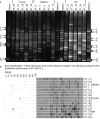Oral microbiota and host innate immune response in bisphosphonate-related osteonecrosis of the jaw
- PMID: 25105817
- PMCID: PMC5153588
- DOI: 10.1038/ijos.2014.46
Oral microbiota and host innate immune response in bisphosphonate-related osteonecrosis of the jaw
Abstract
Bacterial biofilms have emerged as potential critical triggers in the pathogenesis of bisphosphonate (BP)-related osteonecrosis of the jaw (ONJ) or BRONJ. BRONJ lesions have shown to be heavily colonized by oral bacteria, most of these difficult to cultivate and presents many clinical challenges. The purpose of this study was to characterize the bacterial diversity in BRONJ lesions and to determine host immune response. We examined tissue specimens from three cohorts (n=30); patients with periodontal disease without a history of BP therapy (Control, n=10), patients with periodontal disease having history of BP therapy but without ONJ (BP, n=5) and patients with BRONJ (BRONJ, n=15). Denaturing gradient gel electrophoresis of polymerase chain reaction (PCR)-amplified 16S rRNA gene fragments revealed less bacterial diversity in BRONJ than BP and Control cohorts. Sequence analysis detected six phyla with predominant affiliation to Firmicutes in BRONJ (71.6%), BP (70.3%) and Control (59.1%). Significant differences (P<0.05) in genera were observed, between Control/BP, Control/BRONJ and BP/BRONJ cohorts. Enzyme-linked immunosorbent assay (ELISA) results indicated that the levels of myeloperoxidase were significantly lower, whereas interleukin-6 and tumor necrosis factor-alpha levels were moderately elevated in BRONJ patients as compared to Controls. PCR array showed significant changes in BRONJ patients with downregulation of host genes, such as nucleotide-binding oligomerization domain containing protein 2, and cathepsin G, the key modulators for antibacterial response and upregulation of secretory leukocyte protease inhibitor, proteinase 3 and conserved helix-loop-helix ubiquitous kinase. The results suggest that colonization of unique bacterial communities coupled with deficient innate immune response is likely to impact the pathogenesis of ONJ.
Figures




References
-
- Ruggiero SL, Dodson TB, Assael LA et al. American Association of Oral and Maxillofacial Surgeons position paper on bisphosphonate-related osteonecrosis of the jaws—2009 update. J Oral Maxillofac Surg 2009; 67(5 Suppl): 2–12. - PubMed
-
- Reid IR, Cornish J. Epidemiology and pathogenesis of osteonecrosis of the jaw. Nat Rev Rheumatol 2012; 8(2): 90–96. - PubMed
-
- Hoefert S, Schmitz I, Tannapfel A et al. Importance of microcracks in etiology of bisphosphonate-related osteonecrosis of the jaw: a possible pathogenetic model of symptomatic and non-symptomatic osteonecrosis of the jaw based on scanning electron microscopy findings. Clin Oral Investig 2010; 14(3): 271–284. - PubMed
-
- Saia G, Blandamura S, Bettini G et al. Occurrence of bisphosphonate-related osteonecrosis of the jaw after surgical tooth extraction. J Oral Maxillofac Surg 2010; 68(4): 797–804. - PubMed
Publication types
MeSH terms
Substances
Grants and funding
LinkOut - more resources
Full Text Sources
Other Literature Sources
Molecular Biology Databases
Research Materials
Miscellaneous

